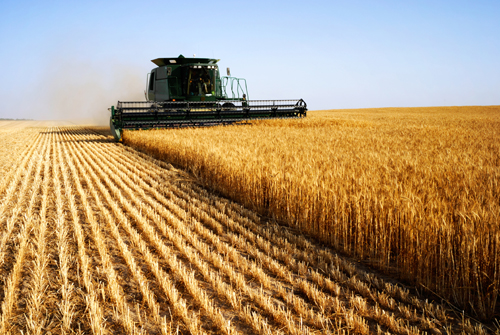
With limited capital, the company known as Zambeef was incorporated in 1994. Employing 60 staff, slaughtering 180 cattle per month in a rented abattoir, delivering meat via a single Land Rover and selling it through two rented butcheries, it was very much a small-scale operation to begin with. Nevertheless, through a combination of organic growth and acquisitions, the company went on to become one of Zambia’s largest agri-businesses, achieving a compounded organic growth rate of over 20 percent in real terms between 2003 and 2008 alone.
Today boasting annual revenues of approximately US$255 million and providing employment for more than 5,500 people, the Zambeef group is principally involved in the production, processing, distribution and retailing of beef, chicken, pork, milk, dairy products, eggs, edible oils, stock feed, flour and bread. The group also has large cereal row cropping operations, principally maize, soya beans and wheat, with approximately 8,350 hectares of row crops under irrigation and 8,650 hectares of rain-fed/dry-land crops available for planting each year. Furthermore, the company is today is the process of rolling out operations into Nigeria and Ghana.
The scale of Zambeef’s current operations is truly staggering. In addition to slaughtering some 60,000 cattle per year it is also responsible for producing approximately eight million litres of milk, 20 million eggs and 120 million tonnes of feed per annum, while also processing 3.5 million chickens and 90,000 hides.
While the size of the business has changed dramatically since the mid-1990s, its vision and strategy remains virtually the same, that being for Zambeef to be seen as the most accessible and affordable quality protein provider in the region, and to increase the efficiency and capacity of its primary production facilities.
To achieve this, the Zambeef group continues to pursue a vertically integrated business model, from primary production to processing and distribution to retailing the finished products in a value-added form directly to the end consumer through its own extensive retail network. The vast majority of Zambeef’s food products are retailed directly to the end consumer through Zambeef’s extensive retail network. Indeed the company has one of the most impressive distribution and retail footprints in Zambia, consisting of 91 retail outlets, three wholesale centres, six fast food outlets and 20 Shoprite butcheries.
The company’s three wholesale centres were opened in 2011 in order to attract business from the large commercial sector in Zambia. Elsewhere, Zambeef is continually investing in upgrading and refurbishing existing stores as well as opening new retail outlets each year. It also operates one of the largest transport and trucking fleets in Zambia, which are serviced and maintained at its own workshop.
One particular quality that the business possesses that assists it in standing out amongst similar enterprises in the region is its commitment to the continuous improvement of its environmental and social management. To this day the company continues to subscribe to the United Nations Millennium Development Goals, while also actively assisting and supporting worthy causes, activities, organisations and charities. Among the important aims that Zambeef supports is the eradication of extreme poverty and hunger, achieving universal primary education, the improvement of basic health care, and the fight against HIV/AIDS, malaria, TB and other diseases.
Zambeef has also signed up to an Environmental and Social Action Plan, which requires the company to achieve a number of international standards on the environment, health and safety, and social responsibility. The most recent independent consultant reports stated that Zambeef continues to make good progress in delivering the approved Environmental and Social Action Plan.
Perhaps not surprising, given its size, Zambeef is one of the largest employers in the country. It also boasts a strong development record, being one of the largest investors in the agricultural sector in Zambia over the last ten years.
The company’s listing on the Lusaka Stock Exchange in 2003 provided an opportunity for Zambian citizens and local pension funds to buy shares in the company. With most local pension funds as shareholders in Zambeef, almost every full-time Zambian employee benefits from the success of Zambeef, which ensures the company helps with wealth creation within Zambia.
Further to this, Zambeef has a number of operations in largely rural areas, and in many of these rural areas the company is one of the largest business partners and employers, through the procurement of locally produced raw materials, resulting in poverty alleviation and sustainable development of these rural economies.
Examining what the immediate future holds for Zambeef it is clear that the company’s aforementioned integrated business model provides it with strong foundations for growth, foundations including the underpinning of margin capture and value-add, the security of its supply chain, and the reducing of risk and earnings volatility.
Several recent large capital investments have certainly helped showcase the company’s determination to grow further still. These have included successfully integrating crop production to its Mpongwe farm ahead of budget, and the upgrading and expansion of its activities at uts subsidiary Zamanita, where it has doubled its crushing capacity.
Targeted re-investment on the other hand is helping to drive Zambeef’s organic growth, specifically through the increasing of its production and efficiencies in its stock feed, dairy and milk processing divisions, and by adding additional retail and wholesale outlets where they are required. All of this combined is expected to see the company return to positive net cash generation over the coming year. This will enable Zambeef to start paying meaningful dividends from 2014.
With the company well placed to achieve its long-term ambition of becoming one of the largest food producers in the region, it is understandable why the board of Zambeef looks forward to the future with confidence.
Written by Will Daynes, research by Jeff Abbott
DOWNLOAD
 Zambeef-AFrica-F&D-Jan14-Bro-s.pdf
Zambeef-AFrica-F&D-Jan14-Bro-s.pdf













